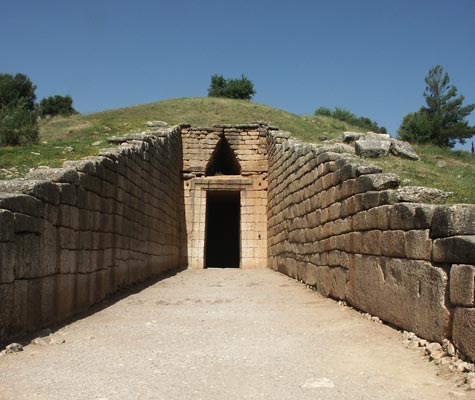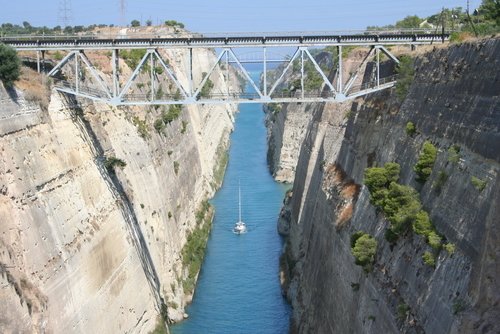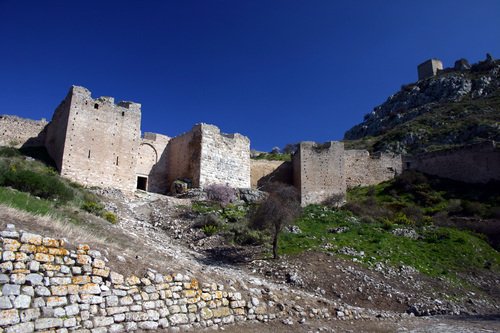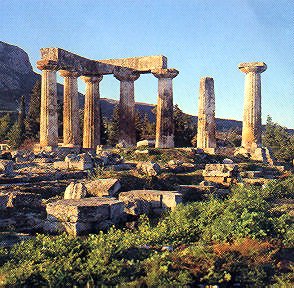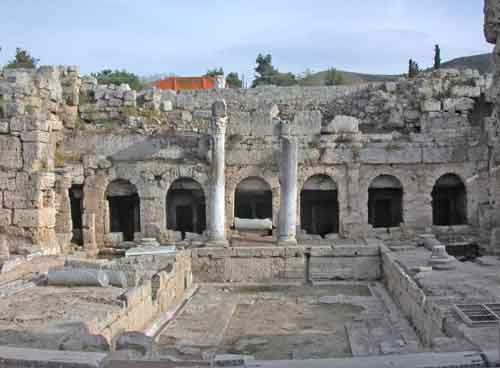THE ARGO-SARONIC ISLANDS
This group of islands is closest to Athens and is worth a visit if you have got extra days or want to have a Greek Island experience but somehow can’t make it to the more famous ones like Santorini, Mykonos, Rhodes, Crete, so on and so forth. Aegina & Angistri can be even done as a day-trip.
However, the most beautiful in the group are the islands of Hydra & Spetses. Others include Salamina, Aegina, Angistri & Poros.
 AEGINA
AEGINAIt is a modest volcanic island, with pine clad hills and proximity to Athens makes it quite popular with both international and national tourists. In our opinion it is worth the effort only if you are keen to visit the Temple of Aphaia. And can be a day-trip from Athens combined with some island hopping. Several tour operators offer a day trip and you can combine the three different islands on a day cruise from Piraeus. If you are planning a stay then the islands of Hydra can be a good alternative. If the
Temple of Aphaia is your main destination, it would be better to sail directly to Agia Marina from Piraeus. You can climb the steep 2km to the temple by foot (or by bus), and then you can either go back to Agia Marina for a swim or take the bus to Aegina town to visit the museum, and to enjoy a quiet afternoon before you take the ferry back to Piraeus or heading off to the other islands.
Attractions:
The major attraction is the
Temple of Aphaia (near Agia Marina) which stands as a proud testimony of Aegina’s contribution to Greek art. The
Ancient Kolonna ((Column that marks the remains of the Temple of Apollo), the
Archaeological Museum on the northern end of town, the restored
Markelos Tower (seat of the first Greek Government) and the
Churches of Ayios Nikolaos & Omorfi Ekklisia can also be explored.
For a relaxed time, enjoying coffee at the numerous cafes lining the promenade and admiring the neoclassical buildings at the harbour can be worthwhile. The streets beyond Aegina harbour are filled with local stores, and can be explored if you want to sample some authentic Greek town life. For beaches the best is Agia Marina, even though it is shallow and can get very crowded.
In Aegina and around Argo-Saronic Islands - the During the day buses leave from Plateia Ethnyersias, every 45 minutes and shuttle between Aegina town and Agia Marina. The tip takes about 30 minutes. From Aegina you can catch ferries and hydrofoils for Angistri, Methana, Peloponnese (20km), Poros (27km), Hydra (56km), and Spetses (84km), so it is possible to visit several islands within one day, but for a more comfortable itinerary a two day tour is advised if you want to visit all the islands (maybe with an overnight stay in Hydra).For taxi’s you can take the first one, in the queue, from the Aegina Island promenade
How to reach: Hydrofoils are the fastest way to get to Aegina (35mins), while a ferry takes an hour. But if you are driving down than the ferry would be the only option. In Piraeus (Athens), ferries and hydrofoils that serve Aegina are docked in gate E8 (see map of Piraeus). You can buy your tickets from the kiosks in Piraeus and return tickets at the port of Aegina. If you plan to catch one of the last ferries back, buy your tickets as soon as you arrive on the island, because they might be sold out later by the afternoon.
More information: http://www.greeklandscapes.com/greece/Aegina%20IslandANGISTRIOnly 15mins by catamaran from Aegina, there is nothing much to do in Angistri unless you are looking to explore some place quieter and with better beaches, than Aegina.
How to reach: From Pireas (Athens) a regular ferry runs at least twice daily (in season) via Aegina and once daily out of season. Catamarans are the fastest way to get to Angistri and take 55 (mins) via Aegina, while a ferry takes two and a half hour. But if you are driving down than the ferry would be the only option. From Aegina you can catch ferries and hydrofoils for Angistri as all who call on her port, go via Aegina
POROS
Poros has somehow has managed to capture the imaginations of quite a few literary figures. But in my opinion the places of intere

st would include:
The ancient Trizina, known as the homeland of Thiseas. it is one of the most interesting places in Poros. All the archaeological finds from ancient Trizina are located in the archaeological Museum
. The Royal cemetery - about 3 kilometer from Trizina is "Vasiliki Tafi"(The Royal cemetery). This area has great interest because of the archaeological finds of the Mycenae enaean period.
The Archeological Museam of Poros
Lemon Forest - Lemon trees grow wild in Mediterranean climates and can be easily recognized by their tangy smell of fresh. This forest is ideal for romantic nice long walks.
Diavologefiro, is famous for its wild beauty. The area is full of blooming flowers and trees. Here the river flows furiously through a deep canyon
How to reach: From Pireas (Athens) & other Argo Saronics Islands there are regular ferry & hydrofoil connections. It can also be reached from the mainland port of Galatas in the Peloponnese. From Pireas it takes around 2:40 hrs to reach by ferry while by hydrofoil it is 1 hr.
More Information: http://www.poros.com.gr/(island’s official website)
 HYDRA
HYDRA
The jewel of the Saronic Gulf, Hydra is a rocky island in the Aegean Sea, about an hour away from Athens and is a favourite with writers and intellectuals. Hydra does not posses any of the golden beaches that grace the other Greek islands, but its rocky shores have their own wild charm. It does boast a healthy night life, but its quiet landscape is its best asset. Main characteristic of Hydra is that there are no wheeled vehicles and the transportation of people is being made only by donkeys, a thing that makes the Island even more romantic.
Beaches - Hydra has a lot of beaches with crystal clear blue waters.
Close to the harbour is a beautiful rocky area with deep blue water, called "Spilia". It attracts many tourists every year and it is an ideal place to enjoy the panoramic harbour view and the magnificent sunset. It is also a place where you can have snacks and drinks, day and night. Beside Spilia, one can find the rocky beach Hydroneta, below the Cannons of the City, with the "Sunset" restaurant to eat. Just next to Hydronetta is a small pebble beach, with lights when the night come down and disco.
Following the road next to the port one can reach Kamini, a small, natural and picturesque port full of fishing boats. Beside to the place Megalo Kamini (Big Kamini) there is Mikro Kamini (Small Kamini), which is a beautiful little pebble beach, ideal for kids and sea sports. Kaminia is the place for traditional and picturesque tavernas and can be reached with sea transportation.
tavernas and can be reached with sea transportation.
Vlihos, is a beautiful beach with clean and clear waters and small white houses to its slopes. It is near the little church of Saint Xaralampos. Vlixos is reached by following the port road, west of the harbour or by sea transportation.
To the left side of the port is located Mandraki, an organized beach, in a close cove, with sea sports, in the facilities of the hotel Mira-Mare. It is only a few minutes away from the main town of Hydra and you can reach it either by walking or with sea transportation.
Bisti is the south-most cove of the island and is surrounded by tall rocks. It is an organized beach and the visitor can dive into the crystal-clear waters.
From the south-west of the island the cove of Saint Nikolaos is reached. Here, one can find an organised pebble beach with clear and clean waters, ideal for underwater fishing.
Other attractions in Hydra (if time and interests permit) would include visit the 6 Monasteries and the 300 churches of Hydra.
How to Reach: From Pireas (Athens) & other Argo Saronics Islands there are ferry & hydrofoil connections. From Pireas it takes around 3:30 hrs to reach by ferry while by hydrofoil it takes approximately 1:30 hrs.
More information on Hydra: http://www.hydra.com.gr/
SPETSES
It is a nice little island ideal for just relaxing and snorkelling. It has vari ous sandy & pebble beaches (the most popular being the Agia Paraskevi and Ag Anargyri) and lovely secluded bays. Its villages are picturesque and authentic and its capital has a number of two-storey neoclassical houses with wooden balconies, coloured walls, and narrow stone-paved alleys.
ous sandy & pebble beaches (the most popular being the Agia Paraskevi and Ag Anargyri) and lovely secluded bays. Its villages are picturesque and authentic and its capital has a number of two-storey neoclassical houses with wooden balconies, coloured walls, and narrow stone-paved alleys.
It is small enough to get around by bike in 4-5 hours. Cars are banned and those on the island are limited to residents only who can only use them out of town and with a permit.There are also horse carriages and a few taxis.
The major attraction apart from the beaches would be the Monastery of Ag. Nikolaos (St. Nicholas), situated just outside Spetses town. The patron saint of this monastery is also a patron of sailors, and it was here the Spetsan leaders took the oath of freedom when the war of Independence was about to break out in 1821.
How to reach: From Pireas (Athens) & other Argo Saronics Islands there are ferry & hydrofoil connections. From Pireas it takes around 4:30 hrs to reach by ferry while by hydrofoil it takes approximately 2 hrs.
More Information: http://en.wikipedia.org/wiki/Spetses















 You can drive all the way up, but it is highly recommended to take the
You can drive all the way up, but it is highly recommended to take the 


 The fire of our Olympic Games were first lit here (if not literally). It was the site of the Olympic Games celebrated every four years by the ancient Greeks. The location of the sanctuary of Olympia in a lush region irrigated by two rivers, the Alpheus and the Cladeus, led Pindar to call it the kallistos topos (most beautiful place) of Greece. It was not a town, but only a sanctuary with buildings associated with games and the worship of the gods.
The fire of our Olympic Games were first lit here (if not literally). It was the site of the Olympic Games celebrated every four years by the ancient Greeks. The location of the sanctuary of Olympia in a lush region irrigated by two rivers, the Alpheus and the Cladeus, led Pindar to call it the kallistos topos (most beautiful place) of Greece. It was not a town, but only a sanctuary with buildings associated with games and the worship of the gods.




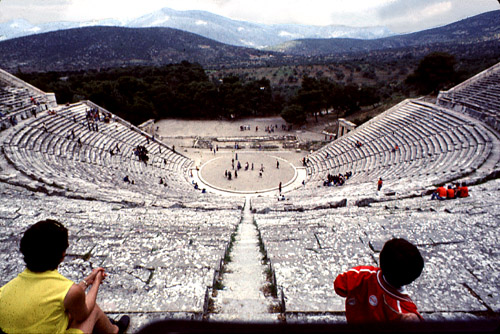





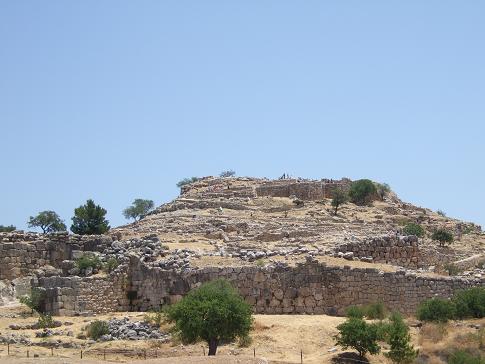
 Lion Gates: It is the earliest known piece of monumental sculpture in the European continent. Through this you enter the Acropolis.
Lion Gates: It is the earliest known piece of monumental sculpture in the European continent. Through this you enter the Acropolis.